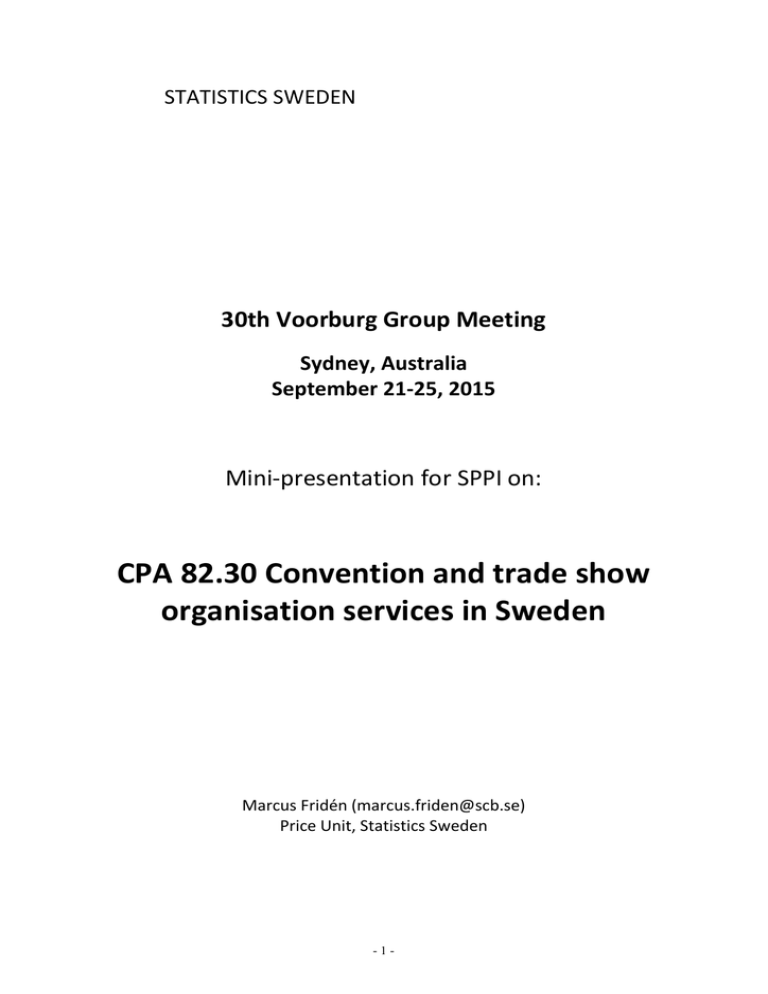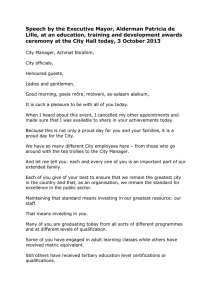CPA 82.30 Convention and trade show organisation services in Sweden
advertisement

STATISTICS SWEDEN 30th Voorburg Group Meeting Sydney, Australia September 21-25, 2015 Mini-presentation for SPPI on: CPA 82.30 Convention and trade show organisation services in Sweden Marcus Fridén (marcus.friden@scb.se) Price Unit, Statistics Sweden -1- Contents 1. Definition of the survey being priced ................................................................ - 3 2. Unit of measure to be priced ............................................................................. - 3 3. Market conditions and constraints ..................................................................... - 3 4. Standard classification structure and product details ........................................ - 3 5. Evaluation of standard vs. definition and market conditions ............................ - 4 6. National accounts concepts and measurement issues related to GDP ............... - 4 7. Pricing methods and criteria for choosing various pricing methods ................. - 5 8. Evaluation of comparability of price indexes with turnover/output data .......... - 5 9. Summary ........................................................................................................... - 6 - -2- 1. Definition of the survey being priced In the Statistical Classification of Products by Activity (CPA 2008) class 82.30, Convention and trade show organisation services, is comprised of two subcategories. The first one is 82.30.11, Convention organisation services, and the other one is 82.30.12, Trade show organisation services. Price indices for 82.30 are under development in Sweden between 2013 and 2015. The results presented in this paper have come from meetings with enterprises and trade organisations and from price collections for four quarters. 2015 will be a trial year for the indices and it will be included in the overall SPPI starting 2016, as well as published separately. 2. Unit of measure to be priced Services produced include marketing, organization and management of events such as trade shows and trade fairs, conventions and congresses. Organisation or provision of secretariat and office facilities and staff for registration or administration where such events take place, as well as supply and setting up of equipment such as audio-visual equipment associated with the organisation of the event are also included in 82.30, among other things. 3. Market conditions and constraints Convention and trade show organisation services has a quite small share of turnover in the Swedish business sector. The turnover in 2013 was about 5.3 billion SEK (≈ €0.5 billion or $0.65 billion), which is less than 0.1 percent of total turnover in the Swedish business sector. The turnover figure has been quite stable since 2006. In the early 2000s the turnover was around 4 billion SEK, and then it rose to 5 billion in 2006, and has been around 5 to 6 billion since then. Not even during the financial crisis, around 2008, were there any noticeable changes concerning revenues, or number of employees. It seems that it is a mature market without any significant growth or innovations. In this regard it should not be particularly difficult to measure prices for Convention and trade show organisation services. The market in Sweden is made up of a lot of small enterprises, 96 percent of the enterprises has less than 10 employees. Because of the relatively small size of the product group in relation to the total business sector there are no large enterprises in this industry. The 10 largest enterprises make up about one third of the total turnover in Convention and trade show organisation services. 4. Standard classification structure and product details The Swedish version of CPA 2008, called SPIN 2007 (Svensk Produktindelning efter Näringsgren 2007) conforms to CPA on the lowest level. However, the 7-digit level is not -3- used anywhere at Statistics Sweden. The 5-digit level is usually the lowest level used in economic statistics in Sweden. Table 1: Classification of products for Organisation of conventions and trade shows SPIN 2007 82.300.01 CPA 2008 82.30.11 Name Convention organisation services 82.300.02 82.30.12 Trade show organisation services 5. Evaluation of standard vs. definition and market conditions Swedish PPIs are product based and therefore we do not use the NACE Rev.2 classification. However, the CPA is a product classification whose elements are related to activities as defined by NACE Rev. 2. So there should be a linkage between the two. When comparing NACE Rev.2 with CPA 2008 for 82.30 it is obvious that there are some important differences. Conferences and meetings are mentioned in NACE but not in CPA. CPA for 82.30 only covers the organisation of conventions and trade shows. Conference hotels and similar establishments are in CPA classified within 55.10.10, Room or unit accommodation services for visitors. Looking at 55.10 in NACE Rev.2 the renting of facilities for conferences and conventions are included there. For 82.30 neither NACE nor CPA mentions anything about the facilities, just the organisation of events. The way I understand it, the renting of rooms and facilities should not belong to 82.30. The renting of conference and convention facilities should probably belong to 55.10.10. Larger events such as trade fairs and congresses should probably belong to 68.20.12, Rental and operating services of own or leased non-residential real estate, which specifically mentions convention centres and exhibition halls. In Sweden, conferences with overnight staying are in general included in 55.10, Hotel and similar accommodation services, which is in line with the classification. One-day conferences are included in 82.30, which seems not to be in line with the classification. However, as long as it is treated in the same way for all statistical products it is probably not considered a significant error source. 6. National accounts concepts and measurement issues related to GDP Since National Accounts is the main user of SPPIs, the demand for service producer price indices within CPA 82 initially came from them. The development of an SPPI for Convention and trade show organisation services was a part of a larger project funded partly by Eurostat Grants that was conducted in 2013 and 2014 at Statistics Sweden. Prices are now being collected as a part of the regular SPPI survey. However, it will not be a part of the overall SPPI index in 2015. -4- Starting from 2016 the index will be published, with base year 2015, and incorporated in the overall SPPI index. Therefore National Accounts will not be able to use the use the index for some years to come. As soon as price indices will be available they will be used as deflators in both ISP (Index of Service Production) as well as in National Accounts. In the mean time National Accounts are using SPPI for 69.2 Accounting and bookkeeping as deflator for this product group. 7. Pricing methods and criteria for choosing various pricing methods The renting of rooms and facilities for one-day conferences and meetings is the most common sold service within this product group in Sweden. Included in the service are often technical equipment, as well as food and drinks. As mentioned in part 5 this might be incorrect according to the classification. But since it is not absolutely clear, they are included in the SPPI survey, and thus treated in the same way in all economic statistics. In the case of conferences and meetings the buyer is almost always an enterprise, which means that there is mostly B2B activities carried out. Unit of measurement is often price per person or price per room. Price determining factors that need to be specified are type of room, as well as other things that are included in the price, such as technical equipment and food and drinks. These kinds of services are usually carried out quite frequently, which mean that it is possible to get prices for repeated services. In the case of Governments or Agencies buying conference services, the price is often fixed in a contract or agreement. Enterprises organising conventions, congresses and trade fairs usually provide prices for showcases or stands. The size of the stand is part of the description of the service and the price is reported per square meter. Some enterprises provide staff that helps in organising events, such as technicians working with construction or installation, or staff that work at the entrance with registration or administration. The hourly charge-out rate is the most preferred pricing method in such cases. Since the buyer is purchasing time, and not a fixed amount of visitors that one staff can register e.g., the use of the hourly rate should not cause any issues in productivity measures. Project management and marketing are also provided by some enterprises. Such services are often tailor made for the customer which makes it difficult to measure prices of repeated services. In the absence of better pricing methods, the hourly charge-out rate is being used. 8. Evaluation of comparability of price indexes with turnover/output data The sample frame for SPPIs in Sweden is the Structural Business Survey at the product level. Thus, turnover data is aligned with price data. -5- 9. Summary Convention and trade show organisation services has a quite small share of turnover, less than 0.1 percent, of the total Swedish business sector. The index is currently in its first year of regular production, and will be published starting 2016. Some inconsistencies in the classifications have been detected. The renting of rooms and facilities for one-day conferences and meetings are included in 82.30 in Sweden, but it is not clear if this really belongs to this product group. Such services are the most common services provided in Sweden, and it often includes technical equipment, as well as food and drinks, which all are price determining factors. Enterprises can, in general, report prices for repeated services. Prices for organisation of conventions, congresses and trade fairs are usually measured in prices per square meter for a showcase or stand. Other services provided, such as technicians, administrative staff, project management and marketing are measured using hourly rates, often as a second best method. -6-




